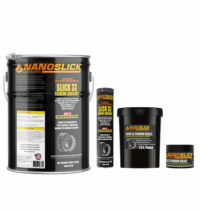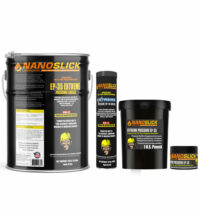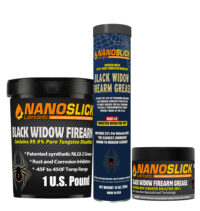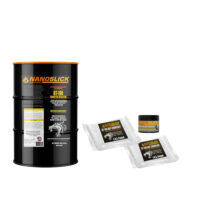Tungsten Disulfide Specs and Analysis
Why does NanoSlick DT-100 Dry Lubricant work so great?
Because, the microstructure of a WS2 (Tungsten Disulfide) crystal is layered hollow sphere with hexagonal crystal clusters, whose surfaces are formed by hexagonal networks with S–W–S molecules combined up, whose layers are connected by Van de Walls Force, this weak binding force is easy to be sheared between layers, so the low friction factor is put up. Meanwhile, WS2 crystal is very stable at high temperature, even above 550F, WS2 builds up a compact WO3 covering layer thereby slowing oxidation and helping inhibit further oxidation, and WO3 has a low friction factor and can prevent the glue effect from happening between metal surfaces as well.
Characteristics Comparison
Characteristics comparison among Tungsten Disulfide(WS2 ), Molybdenum Disulfide (MoS2 ) and Graphite show that Tungsten Disulfide offers a far superior lubrication under extreme conditions of Load, Vacuum and Temperature. The properties below show that Tungsten Disulfide offers excellent thermal stability and oxidation resistance at higher temperatures. WS2 has thermal stability advantage of 93oC (200oF) over MoS2. Coefficient of Friction of WS2 actually reduces at higher loads.
WS2 powder also works as an additive for lubricants (such as oil, grease & other synthetic lubricants) The powder can be mixed 1% to 15% v/v (as required) with grease or oil. This will enhance lubricity of the mixture and also improves High Temperature and Extreme Pressure properties of mixture. During the use, WS2 in the mixture will get coated on mating/moving parts, which in turn reduces friction and improves lubricity and load bearing ability for much longer cycles.
Coating NanoSlick DT-100 Dry Lubricant on a substrate requiring (dry) lubricity
Tungsten Disulfide can be coated by spraying at 120 psi (0.8 Mpa) the substrate with dry (& cool) pneumatic air. It does not require any binders and spraying can be done at normal room temperature. Coated film will be 0.5 micron thick. In an alternative application method, the powder can also be mixed with Isopropyl alcohol and this paste could be buffed to the substrate. The coating applications are already established in many areas such as Automotive parts, Racing Car Engine and other parts, Aerospace parts, Bearings (Linear, Ball, Roller etc), Shafts, Marine parts, Cutting Tools, Blades, Slitters, Knives, Mold release, Precision Gears, Valve components, Pistons, Chains, Machinery components and many other areas.Besides, it can also be applied to antifriction material in carbon industry; super rigidity material and weld thread.
Tungsten Disulfide (WS2) can be used instead of Molybdenum Disulfide (MoS2) in almost all applications, and even more. Since the powder offers one of the lowest Coefficient of Friction (Dynamic at 0.03 & Static at 0.07), the applications are unlimited and could be tried with every conceivable idea.
NanoSlick DT-100 Dry Lubricant Extends Gearbox Life
These gears are from a high-precision gearbox where WS2 is applied to reduce friction and extend life. Coated gears run with lower friction, higher efficiency (7-9%), will run at higher speeds and with a significantly longer life. A Formula 3000 team owes its success to its WS2 coated gearbox. WS2 coated CV joints took part in the Paris – Dakar rally.
Analysis of NanoSlick DT-100 Dry Lubricant and Motor Oil by Randy Elliott
I took the weight of my Mobil 1 oil and it is 840 grams per liter, 1 ppm would be 840 grams divided by 1,000,000 which is .00084 grams, .00084 grams is 1 part per million/ ppm of a litre of oil. .7 grams WS2 is 1/4 ounce. 7 grams divided by 5 quarts is 1.4 grams WS2 per quart oil. 1.4 grams WS2 per quart / 840 grams is your ratio. There are 28 grams in an ounce.
If I wanted 1700 ppm WS2 in my 1 quart/litre of oil then I would multiply .00084 ppm X 1700 ppm which comes to 1.42 grams WS2 to achieve 1700 parts per million WS2 in a quart. It would take 1.42 grams WS2 X 5 quarts is 7 grams WS2 for 5 quarts oil. A liter and quart is very little difference in weight and grams.
If I am right ..
If I am right then 1700 ppm WS2 is perfect, for example I use a Group 1V POA XD3 0-30 Esso syn oil, (Esso is Canadian version of EXXON, this syn XD3 unfortunately is not available in U.S.) ,this XD3 has ZDDP content of 1500 ppm which is a stellar oil pack (CI-4/SL version of it which is all that I will use, not the ZDDP and TBN starved CJ-4 new version). I see 1700 parts per million in WS2 as perfect for first few Oil Changes to fully coat and treat the metal but I believe that should be cut down after first few OCIs.
Delo 400 used to be 200 ppm moly, now 50 ppm. Mobil 1 0-40 is 80 ppm moly. Many people in my oil forums say 250 ppm moly is a great mix in oil, I see 1700 ppm as great for first few OCIs (oil change intervals). But to achieve 250 ppm WS2 after the initial high dosages of WS2 in first few OCIs then one can take 250 ppm WS2 X .00084 (1 ppm of quart/litre) = .21 grams WS2 per quart, that would be 1 gram WS2 per 5 quarts to achieve 250 ppm WS2 in oil.
Other WS2 sites are advocating 25 grams WS2 per quart/litre oil in engines, another site says 5 grams WS2 per litre/quart engine oil, that is 5-18 more WS2. 5 grams per litre oil would be 6000 ppm WS2, 25 grams would be 30,000 ppm WS2. WS2 in my research covers metal at .06 micron, 1500 ppm ZDDP amply covers engine parts, I cant imagine needing 6000 – 30,000 ppm like other sites are advocating.
Am I on right track in ppm calculations?
I have to believe that if I take the weight of oil and divide by 1,000,000 then I get a ppm decimal value which is .00084 for a liter of oil. If I want 1000 ppm then I multiply .00084 X 1000 and I need .84 grams WS2 per litre of oil to get 1000 ppm. If I am right then you can do the same with your American Measurement. 45 years ago Canada was Imperial measurements before Metric came in, the only difference between American and Canadian measurements 45 years ago was an American Gallon was 20% smaller than an Imperial Canadian gallon, all other values in ounces, quarts etc. was exactly the same.
That might make the hair on the back of your neck stand up!
1/4 ounce or 7 grams per litre/quart gear host oil in manual transmission or diff would be about 8400 ppm, I have no problem with that because there is no problem with filter and the host oil is longer term in those applications. Many people would think 5 grams (5 grams = 1 teaspoon) per litre/quart is very little and would think nothing of doing that in a filtered engine, 25 grams per litre is way out there, they are advocating 1 ounce WS2 per litre oil at 25 grams per liter oil, there is .28 grams in 1 ounce. That might make your hair on back neck stand up a bit.
4.9 grams is one teaspoon, there are about 92 teaspoons in a lb, there is 454 grams in a lb. I could use 1 teaspoon WS2 per 4 liter oil capacity and be right in ball park at about 1700 ppm, 7 grams is 1/4 ounce, there are 4.9 grams per teaspoon, 7 grams divided by 4.9 grams is 1.4 teaspoon, 1.4 teaspoon WS2 is 1/4 ounce. Rule of thumb, on 5 quarts oil then 1.4 teaspoons WS2 will render 1700 ppm WS2 and be very close to 1/4 ounce WS2. Those are 4.9 gram teaspoons, .1740 ounce = one teaspoon.
Best to use a good measuring spoon or other calibrated device
Best to use a cooking type measure spoon for accuracy if using the 1.4 teaspoon method for 5 quarts. I will just get into the wife’s cutlery drawer and steal a cooking measure teaspoon and a 1/2 measuring teaspoon on a 5 litre OCI or use 1 teaspoon + a hair more WS2 on 4 liter OCI. This stuff is basically organic in my reading so a good wash on spoon is all one would have to do after I presume. I am probably boring you with this Jeff and you probably have all this figured out already.
I figure 1700 ppm on first few OCIs will work and then go 250 ppm on each OCI after, 1700 ppm is what you are advocating on 5 quarts oil with 1/4 ounce WS2 in my calculations.
-
NanoSlick Slick-33 Ultra Low Friction Grease
Rated 4.93 out of 5$24.95 – $1,693.95 -
NanoSlick EP-35 Extreme Pressure Grease
Rated 4.91 out of 5$26.95 – $1,793.95 -
NanoSlick Black Widow Tungsten Firearm Lubricant
Rated 4.95 out of 5$21.95 – $57.95 -
NanoSlick DT-100 Tungsten Disulfide Lubricant
Rated 4.94 out of 5$36.95 – $8,373.95




